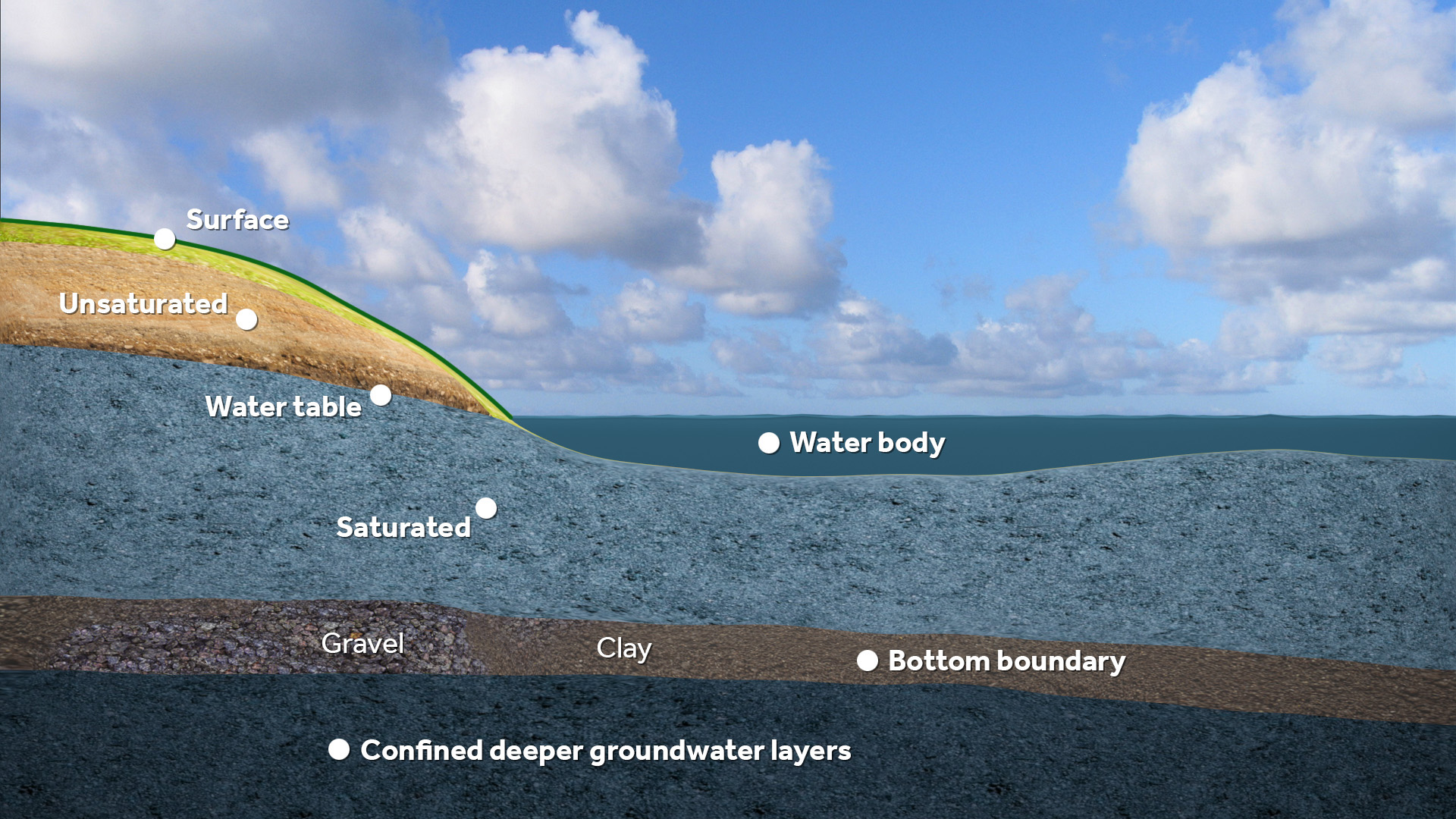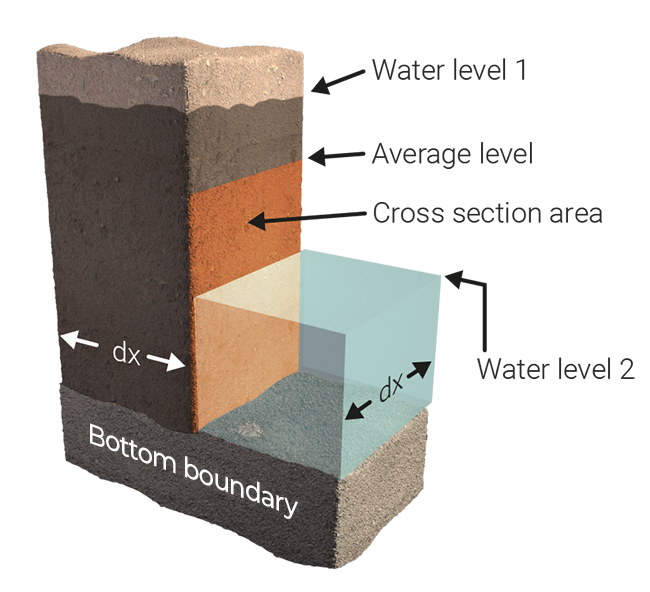Ground model (Water Overlay): Difference between revisions
No edit summary |
No edit summary |
||
| Line 1: | Line 1: | ||
[[File: | [[File:Water_module_layers.jpeg]] | ||
The Water Module also contains a simplified 2-layer ground model, for infiltration, evaporation and horizontal flow in the ground. Additionally, the model also applies a simplified form of exfiltration of water from the soil back onto the surface layer. | The Water Module also contains a simplified 2-layer ground model, for infiltration, evaporation and horizontal flow in the ground. Additionally, the model also applies a simplified form of exfiltration of water from the soil back onto the surface layer. | ||
Revision as of 12:31, 5 March 2024
The Water Module also contains a simplified 2-layer ground model, for infiltration, evaporation and horizontal flow in the ground. Additionally, the model also applies a simplified form of exfiltration of water from the soil back onto the surface layer.
Groundwater modes
For the Water Module there exist three modes for handling groundwater:
- None
- Infiltration only (selected by default for the flooding and rainfall overlay)
- Complete (selected by default for the groundwater overlay)
Two Layered model
The assumption is made that ground is bound vertically by the surface of the terrain at the top and by an impenetrable layer at the bottom. The distance between the surface and the impenetrable layer, and thus the effective height of the ground, is equal to GROUND_BOTTOM_DISTANCE_M. In other words, the impenetrable ground layer is assumed to be a set distance below the surface. The distance is uniform across the entire project area, and thus the impenetrable follows the profile of the surface.
The fraction of water the ground can store per volume is defined with the WATER_STORAGE_PERCENTAGE attribute of the ground layer terrain.
The ground is composed of 2 layers: the unsaturated zone and the saturated zone. The saturated zone is the region of the ground where the soil is fully saturated with water. The unsaturated zone is the region of the ground located directly above the saturated zone. This region can also contain water, but the amount contained is always less than the maximum storage fraction. Water in the unsaturated zone is assumed to be uniformly distributed across the entire height of the zone.
The edge between the unsaturated and saturated zone is defined as the groundwater level, also known as the watertable.
The groundwater table is the height of the top of the saturated zone, relative to datum. The amount of water in the saturated zone is determined with the datum height of the groundwater table, the datum height of the surface, the GROUND_BOTTOM_DISTANCE_M and the ground terrain's WATER_STORAGE_PERCENTAGE.
Initialization
The ground water level is initialized with the values of the ground water prequel connected to the water model. If no ground water data is connected, the ground water level relative to datum is equal to the surface water level relative to datum, as defined by the WATER_LEVEL attribute of the water area in that location. If no water area exists there either, the groundwater level is set to one meter below the surface.
Vertical flow
Vertical ground water flow is modeled as infiltration.
Horizontal flow and aquifers
Ground flow is different from surface flow, since it has to account for the slowdown and porousness of the medium. In general, horizontal ground flow is calculated using formulas described in Harbaugh 2005[1][2]. Depending on the configuration of the Water Overlay , the flow can also be calculated using a KD values instead of K. However, when an aquifer is present, the horizontal aquifer flow variant is applied.
Ground bottom flow
Water can also seep into the ground from deeper ground layers due to pressure from higher regions outside the project area. The speed at which the ground bottom flow occurs is dependent on the local ground water levels, the head (pressure) of the higher regions and the resistance of the layer separating the saturated zone of the freatic ground layer and deeper ground layer.
Note that ground bottom flow can also be negative, allowing water to seep out of the project area to lower regions elsewhere.
Drainage
Drainages are hydraulic structures that provide connections between the ground and nearby waterways, draining groundwater to levels which are optimal for agriculture. Drainage can be passive, where water drains based on water head differences, or active, where the water is pumped from the drain to the nearby waterway. Additionally, the datum height below ground and the overflow height in the waterway can be configured.
Notes
- The sewer is explicitly not part of the ground model, and is not affected by the GROUND_WATER attribute nor by the ground model directly.
Related
The following topics are related to this models.
- Formulas
- Groundwater level formula (Water Overlay)
- Ground flow formula (Water Overlay)
- Ground evaporation formula (Water Overlay)
- Surface infiltration formula (Water Overlay)
- Ground bottom flow formula (Water Overlay)
- Ground infiltration formula (Water Overlay)
- Models
- Surface model (Water Overlay)
- Evaporation model (Water Overlay)
- Infiltration model (Water Overlay)
- Tracer flow model (Water Overlay)
References
- ↑ Harbaugh, A.W., 2005, MODFLOW-2005, the U.S. Geological Survey modular ground-water model-the Ground-Water Flow Process: U.S. Geological Survey Techniques and Methods 6-A16, variously paginated.
- ↑ Langevin, C.D., Hughes, J.D., Banta, E.R., Niswonger, R.G., Panday, Sorab, and Provost, A.M. (2017) ∙ Documentation for the MODFLOW 6 Groundwater Flow Model: U.S. Geological Survey Techniques and Methods, book 6, chap. A55 ∙ p 31 ∙ found at: https://doi.org/10.3133/tm6A55 (last visited 2019-02-04)






